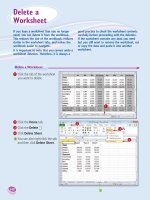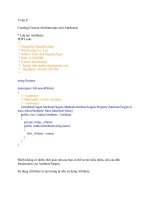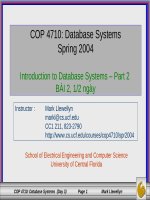Tài liệu Database Systems - Part 12 docx
Bạn đang xem bản rút gọn của tài liệu. Xem và tải ngay bản đầy đủ của tài liệu tại đây (215.52 KB, 17 trang )
COP 4710: Database Systems (Day 12) Page 1 Mark Llewellyn
COP 4710: Database Systems
Spring 2004
Introduction to Normalization – Part 3
BÀI 12, 1/2 ngày
COP 4710: Database Systems
Spring 2004
Introduction to Normalization – Part 3
BÀI 12, 1/2 ngày
School of Electrical Engineering and Computer Science
University of Central Florida
Instructor : Mark Llewellyn
CC1 211, 823-2790
/>COP 4710: Database Systems (Day 12) Page 2 Mark Llewellyn
!
"
!#!
$!!%&'
!!()&
*
!!'$
+,
-→.
/,
,
0
1
≤1≤$%&2
/,
&%&
021
/
3
!
"
!!
/
4
RR
a
1b
b
≠
=
a
1b
b
RR
=
−
COP 4710: Database Systems (Day 12) Page 3 Mark Llewellyn
Let R = (A, B, C, D, E)
K = {AB, AC}
F = {AB→CDE, AC→BDE, B→C, C→B, C→D, B→E}
Step 1: D = {(ABCDE), (ACBDE), (BC), (CB), (CD), (BE)}
Reduce to: D = {(ABCDE), (BC), (CD), (BE)}
Step 2: Does D contain a candidate key for R?
Yes, in (ABCDE)
Step 3: Are all the attributes of R contained in D?
Yes.
Return D as: {(ABCDE), (BC), (CD), (BE)}
5678
COP 4710: Database Systems (Day 12) Page 4 Mark Llewellyn
"
"
!
"
!#!
$!!%&'
!!(*
)&*
91**
" !!'$
0'→.→(:'.2
374('
3'4
"
3.4('
"
3.4
*6&
1*
)
*
COP 4710: Database Systems (Day 12) Page 5 Mark Llewellyn
Let R = (A, B, C, D, E)
K = {AB, AC}
F = {AB→CDE, AC→BDE, B→C, C→B, C→D, B→E}
Step 1: R not in 3NF since AB → C → D
Decompose to: R
1
= (A, B, C, E) with K
1
= K = {AB, AC}
R
2
= (C, D) with K
2
= {C}
Step 2: R
2
in 3NF. R
1
not in 3NF since AB → B → E
Decompose R
1
to: R
11
= (A, B, C) with K
11
= K
1
= K = {AB, AC}
R
12
= (B, E) with K
12
= {B}
Step 3: R
2
, R
11
, and R
12
are all in 3NF
Step 4: Test for the lossless join property (see next page).
5678"
COP 4710: Database Systems (Day 12) Page 6 Mark Llewellyn
AB→CDE: (1
st
time: equates nothing)
AC→BDE: (1
st
time: equates nothing)
B→C: (1
st
time: equates a
3
& b
33
)
C→B: (1
st
time: equates a
2
& b
12
)
C→D: (1
st
time: equates b
14
, b
24
, b
34
) – stop second row becomes all a’s
B→E: (1
st
time: equates a
5
, b
15
, b
25
)
Decomposition has the lossless join property.
;<=%>?
A B C D E
(CD)
b
11
a
2
a
3
a
4
b
15
(ABC)
a
1
a
2
a
3
a
4
b
15
(BE)
b
31
a
2
a
3
a
4
a
5
COP 4710: Database Systems (Day 12) Page 7 Mark Llewellyn
Let R = (A, B, C, D, E)
F = {AB→CDE, AC→BDE, B→C, C→B, C→D, B→E}}
D = {(CD), (ABC), (BE)}
G = F[CD] ∪ F[ABC] ∪ F[BE] Z = Z ∪ ((Z ∩ R
i
)
+
∩ R
i
)
Test for AB→CDE
Z = AB,
= {AB} ∪ ((AB ∩ CD)
+
∩ CD)
= {AB} ∪ ((∅)
+
∩ CD)
= {AB} ∪ (∅ ∩ CD)
= {AB} ∪ (∅)
= {AB}
= {AB} ∪ ((AB ∩ ABC)
+
∩ ABC)
= {AB} ∪ ((AB)
+
∩ ABC)
= {AB} ∪ (ABCDE ∩ ABC)
= {AB} ∪ (ABC)
= {ABC}
= {ABC} ∪ ((ABC ∩ BE)
+
∩ BE)
= {ABC} ∪ ((B)
+
∩ BE)
= {ABC} ∪ (BCDE ∩ BE)
= {ABC} ∪ (BE)
= {ABCE}
;@9*
COP 4710: Database Systems (Day 12) Page 8 Mark Llewellyn
Test for AB→CDE continues
Z = {ABCE} ∪ ((ABCE ∩ CD)
+
∩ CD)
= {ABCE} ∪ ((C)
+
∩ CD)
= {ABCE} ∪ (CBDE ∩ CD)
= {ABCE} ∪ (CD)
= {ABCDE} thus, AB→CDE is preserved
Test for AC→BDE
Z = AC
= {AC} ∪ ((AC ∩ CD)
+
∩ CD)
= {AC} ∪ ((C)
+
∩ CD)
= {AC} ∪ (CBDE ∩ CD)
= {AC} ∪ (CD)
= {ACD}
= {ACD} ∪ ((ACD ∩ ABC)
+
∩ ABC)
= {ACD} ∪ ((AC)
+
∩ ABC)
= {ACD} ∪ (ACBDE ∩ ABC)
= {ACD} ∪ (ABC)
= {ABCD}
;@9*
$
COP 4710: Database Systems (Day 12) Page 9 Mark Llewellyn
Test for AC→BDE continues
Z = {ABCD} ∪ ((ABCD ∩ BE)
+
∩ BE)
= {ABCD} ∪ ((B)
+
∩ BE)
= {ABCD} ∪ (BCDE ∩ BE)
= {ABCD} ∪ (BE)
= {ABCDE} thus, AC→BDE is preserved
Test for B→C
Z = B
= {B} ∪ ((B ∩ CD)
+
∩ CD)
= {B} ∪ ((C)
+
∩ CD)
= {B} ∪ (CBDE ∩ CD)
= {B} ∪ (CD)
= {BCD} thus B→C is preserved
Test for C→B
Z = C
= {C} ∪ ((C ∩ CD)
+
∩ CD)
= {C} ∪ ((C)
+
∩ CD)
= {C} ∪ (CBDE ∩ CD)
= {C} ∪ (CD)
= {CD}
;@9*
$
COP 4710: Database Systems (Day 12) Page 10 Mark Llewellyn
Test for C→B continues
Z = {CD} ∪ ((CD ∩ ABC)
+
∩ ABC)
= {CD} ∪ ((C)
+
∩ ABC)
= {CD} ∪ (CBDE ∩ ABC)
= {CD} ∪ (BC)
= {BCD} thus, C→B is preserved
Test for C→D
Z = C
= {C} ∪ ((C ∩ CD)
+
∩ CD)
= {C} ∪ ((C)
+
∩ CD)
= {C} ∪ (CBDE ∩ CD)
= {C} ∪ (CD)
= {CD} thus C→D is preserved
Test for B→E
Z = B
= {B} ∪ ((B ∩ CD)
+
∩ CD)
= {B} ∪ ((∅)
+
∩ CD)
= {B} ∪ (∅)
= {B}
;@9*
$
COP 4710: Database Systems (Day 12) Page 11 Mark Llewellyn
Test for B→E continues
Z = {B} ∪ ((B ∩ ABC)
+
∩ ABC)
= {B} ∪ ((B)
+
∩ ABC)
= {B} ∪ (BCDE ∩ ABC)
= {BC} ∪ (BC)
= {BC}
Z = {BC}
= {BC} ∪ ((BC ∩ ABC)
+
∩ ABC)
= {BC} ∪ ((C)
+
∩ ABC)
= {BC} ∪ (CBDE ∩ ABC)
= {BC} ∪ (BC)
= {BC}
Z = {BC}
= {BC} ∪ ((BC ∩ BE)
+
∩ BE)
= {BC} ∪ ((B)
+
∩ BE)
= {BC} ∪ (BCDE ∩ BE)
= {BC} ∪ (BE)
= {BCE} thus, B →E is preserved.
;@9*
$
COP 4710: Database Systems (Day 12) Page 12 Mark Llewellyn
•
Why would you use algorithm 3NF.2 rather than
algorithm 3NF.1 when you know that algorithm
3NF.1 will guarantee that both the lossless join
property and the preservation of the functional
dependencies?
•
The answer is that algorithm 3NF.2 will typically
produce fewer relational schemas than will algorithm
3NF.1. Although both the lossless join and
dependency preservation properties must be
independently tested when using algorithm 3NF.2.
A&8"9
COP 4710: Database Systems (Day 12) Page 13 Mark Llewellyn
!
"
!#!
$!
!!(*1
)&*
91* &B<@$
!$
C*!*D &B<@$
-D
3-∪
∪
"
∪∪
4(
≤≤$
ED(-
1!&!
%&!(
&%&
COP 4710: Database Systems (Day 12) Page 14 Mark Llewellyn
•
Algorithm 3NF.3 is very similar to algorithm 3NF.1,
differing only in how the schemas of the
decomposition scheme are created.
–
In algorithm 3NF.1, the schemas are created directly from F.
–
In algorithm 3NF.3, the schemas are created from a minimal
cover for F.
•
In general, algorithm 3NF.3 should generate fewer
relation schemas than algorithm 3NF.1.
COP 4710: Database Systems (Day 12) Page 15 Mark Llewellyn
•
The algorithm given on page 14 of Day 11 notes for testing the
preservation of a set of functional dependencies on a
decomposition scheme is fairly efficient for computation, but
somewhat tedious to do by hand.
•
On the next page is an example solving the same problem that
we did in the example on page 16 of Day 11, utilizing a different
technique which is based on the concept of covers.
•
Given D, R, and F, if D = {R
1
, R
2
, , R
n
) then
G = F[R
1
] ∪ F[R
2
] ∪ F[R
3
] ∪ ∪ F[R
n
] and if every
functional dependency in F is implied by G, then G covers F.
•
The technique is to generate that portion of G
+
that allows us to
know if G covers F.
9E9
*
COP 4710: Database Systems (Day 12) Page 16 Mark Llewellyn
Let R = (A, B, C, D)
F = {A→B, B→C, C→D, D→A}
D = {(AB), (BC), (CD)}
G = F[AB] ∪ F[BC] ∪ F[CD]
Projection onto schema (AB)
F[AB] = A
+
∪ B
+
∪ (AB)
+
= {ABCD} ∪ {ABCD} ∪ {ABCD}
apply projection: = {AB} ∪ {AB} ∪ {AB} = {AB}, A→B is covered
Projection onto schema (BC)
F[BC] = B
+
∪ C
+
∪ (BC)
+
= {BCDA} ∪ {CDAB} ∪ {BCDA}
apply projection: = {BC} ∪ {BC} ∪ {BC} = {BC}, C→C is covered
F&G568H
9E
COP 4710: Database Systems (Day 12) Page 17 Mark Llewellyn
Projection onto schema (CD)
F[CD] = C
+
∪ D
+
∪ (CD)
+
= {CDAB} ∪ {DABC} ∪ {CDAB}
apply projection: = {CD} ∪ {CD} ∪ {CD} = {CD}, C→D is covered
•
Thus, the projections have covered every functional dependency
in F except D → A. So, now the question becomes does G
logically imply D → A?
•
Generate D
+
(with respect to G) and if A is in this closure the
answer is yes.
Therefore, G D ⊨ → A
F&G568H
9E
$
}A,B,C,D{D
G
=
+









